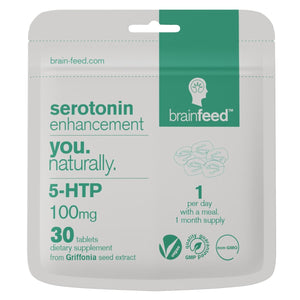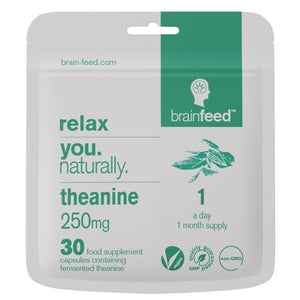Anxiety and the brain: 5 tips on how to relax your mind
filter
Feeling present, calm, and certain as much as possible in your life is a widespread human tendency. Even though you might already have a strategy in place to help you relax, it’s always good to have more tips and tricks to regulate your mood and the best way to calm anxiety up your sleeve. This article takes you through the link between diet and anxiety and natural ways to reduce anxiety to help you become a more relaxed you.
What happens in the brain during anxiety?
Anxiety is a natural response in situations in which someone feels like they’re in danger, causing overactivation of the brain regions responsible for emotional processing. It usually happens when someone perceives threats in their environment which results in uncertainty and increased alertness which means anxiety and the brain truly are intertwined[1 Trusted Source 2021 - Healthline 3rd-party source Anxiety Isn’t Just a Passing State — Sometimes, It’s More of a Trait ] . Anxiety can be expressed as a psychophysiological state known as state anxiety or as a personality trait known as trait anxiety[2 Trusted Source 2020 - Clinical Psychology Review Systematic and meta-analysis Specificity of trait anxiety in anxiety and depression: Meta-analysis of the State-Trait Anxiety Inventory ] ,[3 Trusted Source 1996 - Personality and Social Psychology Bulletin Research evaluation Controlling Self and Others: A Theory of Anxiety, Mental Control, and Social Control ] ,[4 Trusted Source 2017 - Trends in Psychiatry and Psychotherapy Human study Trait vs. state anxiety in different threatening situations ] . State anxiety is the direct reaction to an uncertain situation at a specific moment[4 Trusted Source 2017 - Trends in Psychiatry and Psychotherapy Human study Trait vs. state anxiety in different threatening situations ] . Imagine being late for work. You experience feelings of anxiety while rushing to work but calm down once you get there. That’s an example of state anxiety. The term trait anxiety refers to one’s personality, describing an individual’s tendency to feel the so-called state anxiety. Therefore, trait anxiety is relatively stable over time[4 Trusted Source 2017 - Trends in Psychiatry and Psychotherapy Human study Trait vs. state anxiety in different threatening situations ] . A US study found that trait anxiety is more connected to state anxiety when it comes to a reaction to something happening in relationships with others[4 Trusted Source 2017 - Trends in Psychiatry and Psychotherapy Human study Trait vs. state anxiety in different threatening situations ] .
Anxiety might be a reminder to:
- set some healthy boundaries and speak up for your needs,
- tell someone how you are feeling,
- take a break from social media,
- move your body and spend some time in nature, and
- reflect on whether your life is in alignment with your goals or values.
Can your diet affect anxiety?
Your diet is important for your physical and mental health as it can affect your mood and your body’s stress response. What foods calm my anxiety? To calm your anxiety before bed and to help manage it during the day, the best foods for anxiety according to research are omega 3s, probiotics, antioxidants and protein.
- Omega 3-rich foods like flax seeds, chia seeds, salmon and shellfish have been shown to help reduce feelings of anxiety[5 Trusted Source 2011 - Brain, Behavior, and Immunity Human study Omega-3 supplementation lowers inflammation and anxiety in medical students: A randomized controlled trial ] .
- Probiotic foods like pickles, sauerkraut and kefir have been shown to help lower anxiety in social contexts[6 Trusted Source 2015 - Psychiatry Research Human study Fermented foods, neuroticism, and social anxiety: An interaction model ] .
- Antioxidant-rich foods like red kidney beans, blackberries, kale and ginger help ease anxiousness[7 Trusted Source 2014 - Current Neuropharmacology Research evaluation Novel Therapeutic Targets in Depression and Anxiety: Antioxidants as a Candidate Treatment ] .
- Tryptophan-rich foods, that contain the building block of serotonin, your feel-good chemical, help mediate feelings of anxiety and help you sleep better[8 Trusted Source 2023 - Healthline 3rd-party source 5 Science-Based Benefits of 5-HTP (Plus Dosage and Side Effects) ] , [9 Trusted Source 2020 - International Journal of Molecular Sciences Research evaluation 5-Hydroxytryptophan (5-HTP): Natural Occurrence, Analysis, Biosynthesis, Biotechnology, Physiology and Toxicology ] . Tryptophan can be found in protein-rich foods such as tofu, meat, and chia seeds. In the brain, tryptophan is converted to 5-htp, transforming into serotonin which regulates your mood[8 Trusted Source 2023 - Healthline 3rd-party source 5 Science-Based Benefits of 5-HTP (Plus Dosage and Side Effects) ] .
How can I calm down?
Amino acids that support serotonin production and the relaxation chemical GABA can support a quick boost in calmness and help you get answers on how to relax a busy brain. Both of those chemicals help you maintain healthy mood regulation, with GABA supporting relaxation without sedation. For those chemicals to work their magic, your body needs to get enough of them. Let’s take a look at how to relax your brain with natural supplements.
Support the production of serotonin and GABA
Your feel-good chemical serotonin gets converted from a natural nutrient known as tryptophan. It’s highly present in protein-rich foods. After ingestion, it gets converted into 5-htp. Only about 1-2% of it travels to the brain where it gets converted into the serotonin that regulates your mood[10 Trusted Source 2020 - The Turkish Journal of Gastroenterology Research evaluation Does Seratonin in the intestines make you happy? ] .
As it can be difficult to eat enough tryptophan-rich foods to experience the effects of serotonin increase, you can opt for a high-quality 5-htp supplement to support serotonin production. Additionally, serotonin also gets converted into your sleep hormone melatonin. You can learn more about the link between 5-htp and melatonin. 98% of brain feed’s tablet is comprised of 5-htp meaning that is the smallest, nutrient-dense tablet available.
L-theanine, an amino acid found in green tea, has been shown to help support feelings of calm[11 Trusted Source 2008 - Asia Pacific Journal of Clinical Nutrition Human study L-theanine, a natural constituent in tea, and its effect on mental state ] . L-theanine helps increase the relaxation chemical named GABA, which helps you feel relaxed but still alert. Trying to reach an efficacious amount of theanine from green tea can lead to digestive issues as multiple compounds in tea are toxic when consumed in high amounts. Instead, opt for brain feed’s L- theanine which is extracted from green tea from the region of Hunan Province in South Central China. It is kept as pure as possible and contains 25 cups worth of theanine in one capsule to ensure science-based results.
As a new customer, you can use the code ‘NEW15’ at the checkout to get 15% off your first purchase.
What is the best natural anxiety remedy?
To feel like you’re tackling the feelings of anxiety from all angles, including self-help techniques in your routine can be beneficial. From the classic ones like exercise, journaling and breathing to less-known ones like social mindfulness and Tai Chi, here’s how to add them to your routine.
1. Exercise: mood and sleep booster
Darkness stimulates the production of the sleep hormone melatonin out of the feel-good chemical serotonin. However, all of that can only happen if your serotonin levels are high enough. Besides nutrition, exercise boosts the production and release of serotonin[12 Trusted Source 2007 - Journal of Psychiatry & Neuroscience Research evaluation How to increase serotonin in the human brain without drugs ] . A comprehensive review of the relationship between exercise and mood concluded that exercise helps with a better mood[12 Trusted Source 2007 - Journal of Psychiatry & Neuroscience Research evaluation How to increase serotonin in the human brain without drugs ] . Another review of 22 studies from different countries also showed that exercise could be a useful treatment for anxiety[13 Trusted Source 2011 - The International Journal of Psychiatry in Medicine Research evaluation Exercise for the Treatment of Depression and Anxiety ] . A study on animals also found that exercise boosts the release of serotonin’s building block tryptophan in the brain[14 Trusted Source 1999 - Neuropsychopharmacology Animal study Activity of Serotonergic Neurons in Behaving Animals ] .
The NHS recommends you exercise for at least 150 minutes a week[15 Trusted Source 2022 - NHS 3rd-party source Self-help - Generalised anxiety disorder in adults ] . They emphasise that the exercise should be moderately intensive so it raises your heart rate and makes you breathe faster. So, next time you’re out with your friends, dance your heart out on the dancefloor.
2. Tai Chi for the win
Tai Chi, an ancient Chinese mind-body practice, offers numerous mental health benefits that can be particularly helpful for those dealing with anxiety. A systematic review and meta-analysis examined multiple studies examining Tai Chi’s effect on well-being[16 Trusted Source 2010 - BMC Complementary and Alternative Medicine Systematic and meta-analysis Tai Chi on psychological well-being: Systematic review and meta-analysis ] . 19 studies focused on anxiety, altogether looking at its effects on 1869 people[16 Trusted Source 2010 - BMC Complementary and Alternative Medicine Systematic and meta-analysis Tai Chi on psychological well-being: Systematic review and meta-analysis ] . The results showed that 1 hour to 1 year of regular Tai Chi reduced anxiety, the benefits being stronger the more you practised it[16 Trusted Source 2010 - BMC Complementary and Alternative Medicine Systematic and meta-analysis Tai Chi on psychological well-being: Systematic review and meta-analysis ] . Another meta-analysis that included 10 studies on anxiety with 950 participants altogether showed that compared with non-mindful exercise, Tai Chi may be more effective in reducing mental health problems[17 Trusted Source 2023 - Journal of Affective Disorders Systematic and meta-analysis The comparative effects of Tai chi versus non-mindful exercise on measures of anxiety, depression and general mental health: A systematic review and meta-analysis ] . The slow, controlled movements of Tai Chi promote relaxation, while the focus and intention required during practice can help clear the mind and create a sense of harmony between the body and mind, called mindfulness which has been frequently linked to relaxation[18 Trusted Source 2015 - Psychology, Health & Medicine Human study Enhancing relaxation states and positive emotions in physicians through a mindfulness training program: A one-year study ] .
While you’re encouraged to join a Tai Chi group and practice these mindful movements in the park, you can also do it at home by yourself. Grab your laptop, search for a tutorial and aim for practising it for 1 hour in a week.
4. Consider others to improve your well-being
Social mindfulness involves considering others' needs and perspectives before making decisions. It has been frequently linked to improved well-being and reduced anxiety. A study on 30 people found that social mindful/unmindful choices can significantly influence an observer’s mood, how much they like the people, and even future social decisions they might make involving them[19 Trusted Source 2020 - Frontiers in Neuroscience Human study Social Mindfulness Shown by Individuals With Higher Status Is More Pronounced in Our Brain: ERP Evidence ] . This suggests that socially mindful behaviour may foster a sense of connectedness and belonging, which can buffer against anxiety and promote overall well-being.
Wondering how to implement that? In everyday life, try slowly counting to 8 before making a decision. This will give you time to think it through and allow you to assess the effects it may have on others. When it comes to making bigger decisions, allow yourself to reflect on them for longer. Read through the science of decision-making if you want to know more.
4. 4 - 7 - 8: The number for self-help
In all mindfulness practices, you learn to focus your awareness on the breath[20 Trusted Source 2023 - Family Medicine Research evaluation Take a Deep Breath ] . It helps you notice what it feels like to breathe in and out. A ‘4 - 7 - 8’ breathing technique is easy to learn and perform while also being easy to incorporate into your life as it’s short and does the job[21 Trusted Source 2023 - Journal of Interprofessional Education & Practice Research evaluation A moment of peace: Utilizing practical on the job relaxation and meditation techniques to improve feelings of stress and burnout among healthcare professionals ] . It encourages relaxation and well-being while reducing stress and tension[21 Trusted Source 2023 - Journal of Interprofessional Education & Practice Research evaluation A moment of peace: Utilizing practical on the job relaxation and meditation techniques to improve feelings of stress and burnout among healthcare professionals ] , [22 Trusted Source 2020 - The Creativity Workbook for Coaches and Creatives 3rd-party source Flipping on the Creative Switch Using the 4, 7, 8 Breathing Technique ] , [23 Trusted Source 2023 - Obesity Surgery Human study The Effect of Deep Breathing Exercise and 4-7-8 Breathing Techniques Applied to Patients After Bariatric Surgery on Anxiety and Quality of Life ] . Take a moment to do it now:
Step 1:Close your eyes and notice the sensations of breathing.
Step 2: Inhale through your nose while slowly counting to 4. Notice what it feels like to have the air enter your body.
Step 3: Hold your breath for a slow count of 7. Don’t clamp your mouth or nose shut.
Step 4: Exhale fully out of your mouth while slowly counting to 8. Notice what it feels like to exhale and let the breath go.
Step 5: Repeat at least 3 times.
5. Snap back to reality
Did you ever experience thinking about negative aspects of your life at a time when you should be sleeping? You are not alone. This process is called ruminating and it involves dwelling on negative feelings which takes us further away from feeling relaxed and joyful[24 Trusted Source 2020 - American Psychiatryic Association 3rd-party source Rumination: A Cycle of Negative Thinking ] . This thought-preoccupating process also makes it difficult to move beyond and focus on problem-solving[23 Trusted Source 2023 - Obesity Surgery Human study The Effect of Deep Breathing Exercise and 4-7-8 Breathing Techniques Applied to Patients After Bariatric Surgery on Anxiety and Quality of Life ] . Wondering what you can do? Journal your thoughts.
A study found that journaling or writing down your thoughts and feelings, rather than just thinking about them, helps with processing emotions and reduces stress and anxiety[25 Trusted Source 2019 - Harward Business Review 3rd-party resource How to Stop Thinking About Work at 3am ] . The results showed that college students who suffered from worrying at bedtime and were randomly assigned to journal every night for a week before bed had improved sleep quality and duration of sleep after following a journaling routine.
Now that you know what can help you achieve relaxation and a better mood, go grab life by its horns and enjoy it!
References
[1] Raypole, C. (2021). Anxiety Isn’t Just a Passing State — Sometimes, It’s More of a Trait. Healthline. https://www.healthline.com/health/anxiety/what-is-trait-anxiety
[2] Knowles, K. A., & Olatunji, B. O. (2020). Specificity of trait anxiety in anxiety and depression: Meta-analysis of the State-Trait Anxiety Inventory. Clinical Psychology Review, 82, 101928. https://www.sciencedirect.com/science/article/abs/pii/S0272735820301161?via%3Dihub
[3] Fiske, S. T., Morling, B., & Stevens, L. E. (1996). Controlling Self and Others: A Theory of Anxiety, Mental Control, and Social Control. Personality and Social Psychology Bulletin, 22(2), 115–123. https://journals.sagepub.com/doi/10.1177/0146167296222001
[4] Leal, P. C., Goes, T. C., da Silva, L. C. F., & Teixeira-Silva, F. (2017). Trait vs. State anxiety in different threatening situations. Trends in Psychiatry and Psychotherapy, 39, 147–157. https://www.scielo.br/j/trends/a/R84KJgHvnjZsxR8FL78yg5D/?lang=en
[5] Kiecolt-Glaser, J. K., Belury, M. A., Andridge, R., Malarkey, W. B., & Glaser, R. (2011). Omega-3 supplementation lowers inflammation and anxiety in medical students: A randomized controlled trial. Brain, Behavior, and Immunity, 25(8), 1725–1734. https://www.sciencedirect.com/science/article/abs/pii/S0889159111004685?via%3Dihub
[6] Hilimire, M. R., DeVylder, J. E., & Forestell, C. A. (2015). Fermented foods, neuroticism, and social anxiety: An interaction model. Psychiatry Research, 228(2), 203–208. https://www.sciencedirect.com/science/article/abs/pii/S0165178115002140?via%3Dihub
[7] Xu, Y., Wang, C., Klabnik, J. J., & O’Donnell, J. M. (2014). Novel Therapeutic Targets in Depression and Anxiety: Antioxidants as a Candidate Treatment. Current Neuropharmacology, 12(2), 108–119. https://www.eurekaselect.com/article/57565
[8] Van De Walle, G. (2023). 5 Science-Based Benefits of 5-HTP (Plus Dosage and Side Effects). Healthline. https://www.healthline.com/nutrition/5-htp-benefits
[9] Maffei, M. E. (2020). 5-Hydroxytryptophan (5-HTP): Natural Occurrence, Analysis, Biosynthesis, Biotechnology, Physiology and Toxicology. International Journal of Molecular Sciences, 22(1), 181. https://www.mdpi.com/1422-0067/22/1/181
[10] Bektaş, A., Erdal, H., Ulusoy, M., & Uzbay, İ. T. (2020). Does Seratonin in the intestines make you happy? The Turkish Journal of Gastroenterology, 31(10), 721–723. https://turkjgastroenterol.org/en/does-seratonin-in-the-intestines-make-you-happy-136614
[11] Nobre, A. C., Rao, A., & Owen, G. N. (2008). L-theanine, a natural constituent in tea, and its effect on mental state. Asia Pacific Journal of Clinical Nutrition, 17(S1), 167–168. https://apjcn.nhri.org.tw/server/apjcn/17%20Suppl%201/167.pdf
[12] Young, S. N. (2007). How to increase serotonin in the human brain without drugs. Journal of Psychiatry & Neuroscience, 32(6), 394–399. https://pubmed.ncbi.nlm.nih.gov/18043762/
[13] Carek, P. J., Laibstain, S. E., & Carek, S. M. (2011). Exercise for the Treatment of Depression and Anxiety. The International Journal of Psychiatry in Medicine, 41(1), 15–28. https://journals.sagepub.com/doi/10.2190/PM.41.1.c
[14] Jacobs, B. L., & Fornal, C. A. (1999). Activity of Serotonergic Neurons in Behaving Animals. Neuropsychopharmacology, 21(1), Article 1. https://www.nature.com/articles/1395336
[15] Self-help - Generalised anxiety disorder in adults (2022). NHS. https://www.nhs.uk/mental-health/conditions/generalised-anxiety-disorder/self-help/
[16] Wang, C., Bannuru, R., Ramel, J., Kupelnick, B., Scott, T., & Schmid, C. H. (2010). Tai Chi on psychological well-being: Systematic review and meta-analysis. BMC Complementary and Alternative Medicine, 10(1), 23. https://bmccomplementmedtherapies.biomedcentral.com/articles/10.1186/1472-6882-10-23
[17] Yin, J., Yue, C., Song, Z., Sun, X., & Wen, X. (2023). The comparative effects of Tai chi versus non-mindful exercise on measures of anxiety, depression and general mental health: A systematic review and meta-analysis. Journal of Affective Disorders, 337, 202–214. https://www.sciencedirect.com/science/article/abs/pii/S0165032723006730?via%3Dihub
[18] Amutio, A., Martínez-Taboada, C., Hermosilla, D., & Delgado, L. C. (2015). Enhancing relaxation states and positive emotions in physicians through a mindfulness training program: A one-year study. Psychology, Health & Medicine, 20(6), 720–731. https://www.tandfonline.com/doi/full/10.1080/13548506.2014.986143
[19] Lu, J., Huang, X., Liao, C., Guan, Q., Qi, X.-R., & Cui, F. (2020). Social Mindfulness Shown by Individuals With Higher Status Is More Pronounced in Our Brain: ERP Evidence. Frontiers in Neuroscience, 13, 1432. https://www.frontiersin.org/journals/neuroscience/articles/10.3389/fnins.2019.01432/full
[20] Myerholtz, L. (2023). Take a Deep Breath. Family Medicine, 55(4), 284–285. https://journals.stfm.org/familymedicine/2023/april/prescol-apr23/
[21] Wood, K., & Carini, C. (2023). A moment of peace: Utilizing practical on the job relaxation and meditation techniques to improve feelings of stress and burnout among healthcare professionals. Journal of Interprofessional Education & Practice, 31, 100613. https://www.sciencedirect.com/science/article/abs/pii/S2405452623000150?via%3Dihub
[22] McNair, D. (2020). Flipping on the Creative Switch Using the 4, 7, 8 Breathing Technique. In E. Maisel (Ed.), The Creativity Workbook for Coaches and Creatives (1st Edition). Routledge. https://www.taylorfrancis.com/books/edit/10.4324/9780429354700/
[23] Aktaş, G. K., & İlgin, V. E. (2023). The Effect of Deep Breathing Exercise and 4-7-8 Breathing Techniques Applied to Patients After Bariatric Surgery on Anxiety and Quality of Life. Obesity Surgery, 33(3), 920–929. https://link.springer.com/article/10.1007/s11695-022-06405-1
[24] Rumination: A Cycle of Negative Thinking (2020). American Psychiatric Association. https://www.psychiatry.org/news-room/apa-blogs/rumination-a-cycle-of-negative-thinking
[25] Zucker, R. (2019). How to Stop Thinking About Work at 3am. Harvard Business Review. https://hbr.org/2019/12/how-to-stop-thinking-about-work-at-3am


 alertness
alertness
 cognition
cognition
 sleep
sleep
 wellbeing
wellbeing





Leave a comment
Open tab